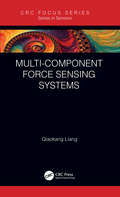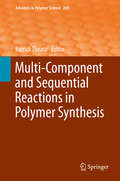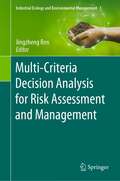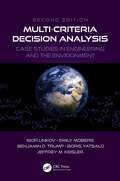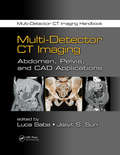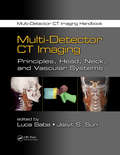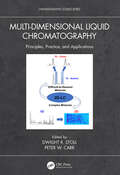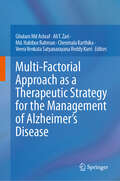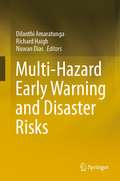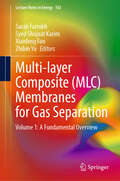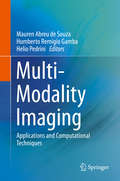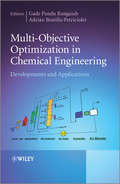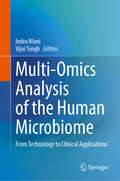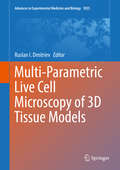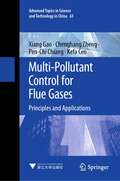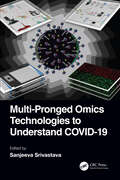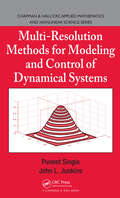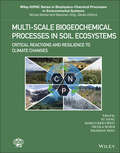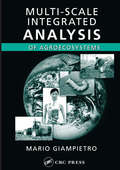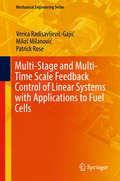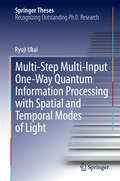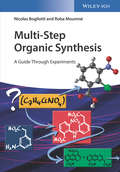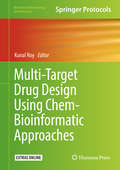- Table View
- List View
Multi-Component Force Sensing Systems (Series in Sensors)
by Qiaokang LiangMulti-Component Force Sensing Systems focuses on the design, development, decoupling, and applications of multi-component force sensing systems. Force and moment information can be used as feedback to form an automatic control system to accomplish efficient manipulation. The origins of force measurement and control can be traced back to the late 1970s. Since then, multi-component F/M (force/moment) sensing systems have been widely known and intensively studied. In the past few years, force measurement practices have been significantly affected by new tools (such as digital force gauges, virtual instrumentation, high speed data acquisition systems, etc.) as well as sophisticated measurement methods such as mechano-magnetic, mechano-optical, etc. However, this is the first book to provide an overview of the topic. It will be a useful reference for students in physics and engineering working with robotic sensing systems and robotic systems, in addition to researchers and those working within industry. This work was supported in part by the National Nature Science Foundation of China (NSFC 62073129 and 61673163). Features: • Explores the development of force/torque sensing systems • Provides real applications of the multi-component force/torque sensing systems • Contains executable code for decoupling algorithms About the Author: Qiaokang Liang is an Associate Professor with the College of Electrical and Information Engineering, Hunan University. He is currently the vice director of the Hunan Key Laboratory of Intelligent Robot Technology in Electronic Manufacturing and serving as the assistant director of the National Engineering Laboratory for Robot Vision Perception and Control. He received his Ph.D. degree in control science and engineering from the University of Science and Technology of China, Hefei, China, in 2011. His research interests include robotics and mechatronics, biomimetic sensing, advanced robot technology, and human–computer interaction.
Multi-Component and Sequential Reactions in Polymer Synthesis
by Patrick TheatoThe series Advances in Polymer Science presents critical reviews of the present and future trends in polymer and biopolymer science. It covers all areas of research in polymer and biopolymer science including chemistry, physical chemistry, physics, material science. The thematic volumes are addressed to scientists, whether at universities or in industry, who wish to keep abreast of the important advances in the covered topics. Advances in Polymer Science enjoys a longstanding tradition and good reputation in its community. Each volume is dedicated to a current topic and each review critically surveys one aspect of that topic, to place it within the context of the volume. The volumes typically summarize the significant developments of the last 5 to 10 years and discuss them critically, presenting selected examples, explaining and illustrating the important principles and bringing together many important references of primary literature. On that basis, future research directions in the area can be discussed. Advances in Polymer Science volumes thus are important references for every polymer scientist, as well as for other scientists interested in polymer science as an introduction to a neighboring field or as a compilation of detailed information for the specialist. Review articles for the individual volumes are invited by the volume editors. Single contributions can be specially commissioned. Readership: Polymer scientists or scientists in related fields interested in polymer and biopolymer science, at universities or in industry, graduate students.
Multi-Criteria Decision Analysis for Risk Assessment and Management (Industrial Ecology and Environmental Management #1)
by Jingzheng RenThis book provides in-depth guidance on how to use multi-criteria decision analysis methods for risk assessment and risk management. The frontiers of engineering operations management methods for identifying the risks, investigating their roles, analyzing the complex cause-effect relationships, and proposing countermeasures for risk mitigation are presented in this book. There is a total of ten chapters, mainly including the indicators and organizational models for risk assessment, the integrated Bayesian Best-Worst method and classifiable TOPSIS model for risk assessment, new risk prioritization model, fuzzy risk assessment under uncertainties, assessment of COVID-19 transmission risk based on fuzzy inference system, risk assessment and mitigation based on simulation output analysis, energy supply risk analysis, risk assessment and management in cash-in-transit vehicle routing problems, and sustainability risks of resource-exhausted cities. The most significant feature of this book is that it provides various systematic multi-criteria decision analysis methods for risk assessment and management, and illustrates the application of these methods in different fields. This book is beneficial to policymakers, decision-makers, experts, researchers and students related to risk assessment and management.
Multi-Criteria Decision Analysis: Case Studies in Engineering and the Environment (Environmental Assessment and Management)
by Jeffrey M. Keisler Igor Linkov Benjamin D. Trump Emily Moberg Boris YatsaloDecision analysis has become widely recognized as an important process for translating science into management actions. With climate change and other systemic threats as driving forces in creating environmental and engineering problems, there is a great need for understanding decision making frameworks through a case-study based approach. Management of environmental and engineering projects is often complicated and multidisciplinary in scope and nature, thus issues that arise can be difficult to solve analytically. Multi-Criteria Decision Analysis: Case Studies in Engineering and the Environment provides detailed description of MCDA methods and tools and illustrates their applications through case studies focused on sustainability and system engineering applications. New in the Second Edition: Addresses current and emerging environmental and engineering problems Includes seven new case studies to illustrate different management situations applicable at the international level Builds on real case studies from recent and relevant environmental and engineering management experience Describes advanced MCDA techniques and extensions used by practitioners Provides corresponding decision models implemented using the DECERNS software package Gives a more holistic approach to teaching MCDA methodology with a focus on sustainable solutions and adoption of new technologies, including nanotechnology and synthetic biology Given the novelty and inherent applicability of this decision-making framework to the environmental and engineering fields, a greater number of teaching tools for this topic need to be made available. This book provides those teaching tools, covering the breadth of the applications of MCDA methodologies with clear explanations of the MCDA process. The case studies are implemented in the DECERNS software package, allowing readers to experiment and explore and to understand the full process by which environmental managers assess these problems. This book is a great resource for professionals and students seeking to learn decision analysis techniques and apply similar frameworks to environmental and engineering projects
Multi-Detector CT Imaging: Abdomen, Pelvis, and CAD Applications
by Martin GardnerDevelopments in CT technology during the last 20 years have impressively improved its diagnostic potentialities. Part of a two-volume set that covers all aspects of CT imaging, Multi-Detector CT Imaging: Abdomen, Pelvis, and CAD Applications contains easily searchable clinical specialty chapters that provide specific information without need of an
Multi-Detector CT Imaging: Principles, Head, Neck, and Vascular Systems
by Jasjit S. Suri Luca SabaDevelopments in CT technology during the last 20 years have impressively improved its diagnostic potentialities. Part of a two-volume set that covers all aspects of CT imaging, Multi-Detector CT Imaging: Principles, Head, Neck, and Vascular Systems contains easily searchable clinical specialty chapters that provide specific information without need
Multi-Dimensional Liquid Chromatography: Principles, Practice, and Applications (Chromatographic Science Series)
by Peter W. Carr Dwight R. StollTwo-dimensional liquid chromatography (2D-LC) is finding increasingly wide application principally due to the analysis of mixtures of moderate to high complexity. Many industries are developing increasingly complex products that are challenging the separation capabilities of state-of-the-art 1D-LC and need new analytical methodologies with substantially more resolving power, and 2D-LC meets that need. This text, organized by two leaders in the field, establishes a sound fundamental basis for the principles of the technique, followed by a discussion of important practical considerations. The book begins with an introduction to multi-dimensional separations and a discussion of the history and development of the technique over the past 40 years, followed by several chapters that provide a theoretical basis for development of 2D-LC methods, including foundational concepts regarding separation complementarity, under-sampling, and dynamics of liquid chromatography separations. Instrumentation for 2D-LC is discussed extensively, including practical aspects such as interface selection and setup. Building on this foundation, two separate chapters are focused on method development for non-comprehensive and comprehensive separations, followed by a chapter dedicated to data analysis. Finally, applications of 2D-LC in several fields ranging from pharmaceutical analysis to polymer science are summarized. The book is an important resource for both students and practitioners who are already using 2D-LC or are interested in getting started in the field. Key Features: Demonstrates the conditions under which a 2D-LC method should be considered as an alternative to a 1D-LC method. Establishes a sound fundamental basis of the principles of the technique, followed by guidelines for method optimization. Provides a single source for technical knowledge advances and practical guidance described in recent literature. Assists with the initial decision to develop a 2D-LC method. Guides the reader in developing a high-quality method that meets the needs of their application.
Multi-Factorial Approach as a Therapeutic Strategy for the Management of Alzheimer’s Disease
by Ghulam Md Ashraf Ali T. Zari Md. Habibur Rahman Chenmala Karthika Veera Venkata Satyanarayana Reddy KarriThis book is a comprehensive guide to the pathology, underlying mechanisms, and treatment options for Alzheimer's disease (AD). The book starts with an introduction to the basic anatomy and physiology of the central nervous system, followed by an overview of the types, classifications, and basic concepts of neurodegenerative disorders. The epidemiology, etiology, risk factors, and future predictions of AD have been covered in detail. The book then delves into the pathophysiology and underlying mechanisms of plaque formation and explores the correlation of AD with other psychological and non-psychological conditions. The chapters also explore the diagnosis of AD, including types of plaques and their detection, imaging techniques, and other tests. The book also covers traditional therapies for AD and explores the potential application of nanotechnology in AD treatment. The book also covers animal models and ethics in the testing of drugs for AD, regulatory guidelines, and the approval process for drugs and formulations for AD. Prevention and reduction of AD risk are explored, including lifestyle changes, dietary changes, supplements, natural medicines (phytoconstituents), and probiotics as the future of AD. The book concludes with a discussion of future barriers and possible solutions with recent advances in the field of AD. This book is an essential guide for students, researchers, and healthcare professionals interested in Alzheimer's disease research.
Multi-Hazard Early Warning and Disaster Risks
by Dilanthi Amaratunga Richard Haigh Nuwan DiasThis book presents a collection of papers under the theme of multi-hazard early warning and disaster risks. These were selected from the presentations made at the International Symposium on Tsunami and Multi-Hazard Risks, Early Warning and Community Awareness in supporting implementation of the Sendai Framework for Disaster Risk Reduction 2015-2030. This conference aimed to recognize achievements and to highlight work that still needs to be carried out. The conference promoted collaboration among academia, research institutions and disaster management offices, and further encouraged multidisciplinary and multi-sectoral interactionThis International Symposium on Multi-Hazard Early Warning and Disaster Risk Reduction provided an important opportunity to reflect upon our progress to date in tackling disaster risk, but also to consider some of the challenges and opportunities that lay ahead of us.A particular focus of this event wasMulti-Hazard Early Warning. During the negotiations for the Sendai Framework, countries and partners highlighted the need to:1. Continue to invest in, develop, maintain and strengthen people-centred, end-to-end early warning systems;2. Promote the application of simple and low cost early warning equipment and facilities;3. Broaden the dissemination channels for early warning information to facilitate early action.Countries also called for the further development of and investment in effective, nationally compatible, regional multi-hazard early warning mechanisms. To address these needs, global Target (g) of the Sendai Framework was adopted, namely to “substantially increase the availability of and access to multi-hazard early warning systems and disaster risk information and assessments to the people by 2030”. As illustrated by recent events in Indonesia, it is also vital to address the challenge of cascading hazards that pose a tsunami risk, and the importance of linking tsunami early warning to a multi-hazard environment. However, moving towards a multi-hazard environment is complex and poses many challenges but can bring significant benefits in terms of efficiencies and also in recognising the links between hazards, such as cascading threats. We very much hope that this book will provide an important platform to address these and other challenges in addressing disaster risk, as well as supporting implementation of the Sendai Framework for Disaster Risk Reduction
Multi-Layer Composite: Volume 1: A Fundamental Overview (Lecture Notes in Energy #102)
by Sarah Farrukh Xianfeng Fan Syed Shujaat Karim Zhibin YuThis book offers an in-depth exploration of the fundamentals of multi-layer composite (MLC) membranes for the gas separation applications. It provides a comprehensive overview of MLC membranes, including their historical development, structural features, fabrication techniques, selection criteria, mathematical models for gas transport, gas separation mechanisms, characterization methods, detailed adsorption mechanisms, current challenges, and future trends in gas separation technology. Serving as a valuable reference, this book is designed for materials scientists, environmental engineers, and chemical engineers seeking fundamental insights into the effective utilization of MLC membranes for energy-efficient gas separation processes.
Multi-Modality Imaging: Applications and Computational Techniques
by Mauren Abreu de Souza Humberto Remigio Gamba Helio PedriniThis book presents different approaches on multi-modality imaging with a focus on biomedical applications. Medical imaging can be divided into two categories: functional (related to physiological body measurements) and anatomical (structural) imaging modalities.In particular, this book covers imaging combinations coming from the usual popular modalities (such as the anatomical modalities, e.g. X-ray, CT and MRI), and it also includes some promising and new imaging modalities that are still being developed and improved (such as infrared thermography (IRT) and photoplethysmography imaging (PPGI)), implying potential approaches for innovative biomedical applications.Moreover, this book includes a variety of tools on computer vision, imaging processing, and computer graphics, which led to the generation and visualization of 3D models, making the most recent advances in this area possible. This is an ideal book for students and biomedical engineering researchers covering the biomedical imaging field.
Multi-Objective Optimization in Chemical Engineering
by Prof Adrián Bonilla-Petriciolet Gade Pandu RangaiahFor reasons both financial and environmental, there is a perpetual need to optimize the design and operating conditions of industrial process systems in order to improve their performance, energy efficiency, profitability, safety and reliability. However, with most chemical engineering application problems having many variables with complex inter-relationships, meeting these optimization objectives can be challenging. This is where Multi-Objective Optimization (MOO) is useful to find the optimal trade-offs among two or more conflicting objectives.This book provides an overview of the recent developments and applications of MOO for modeling, design and operation of chemical, petrochemical, pharmaceutical, energy and related processes. It then covers important theoretical and computational developments as well as specific applications such as metabolic reaction networks, chromatographic systems, CO2 emissions targeting for petroleum refining units, ecodesign of chemical processes, ethanol purification and cumene process design.Multi-Objective Optimization in Chemical Engineering: Developments and Applications is an invaluable resource for researchers and graduate students in chemical engineering as well as industrial practitioners and engineers involved in process design, modeling and optimization.
Multi-Omics Analysis of the Human Microbiome: From Technology to Clinical Applications
by Vijai Singh Indra ManiThis book introduces the rapidly evolving field of multi-omics in understanding the human microbiome. The book focuses on the technology used to generate multi-omics data, including advances in next-generation sequencing and other high-throughput methods. It also covers the application of artificial intelligence and machine learning algorithms to the analysis of multi-omics data, providing readers with an overview of the powerful computational tools that are driving innovation in this field. The chapter also explores the various bioinformatics databases and tools available for the analysis of multi-omics data. The book also delves into the application of multi-omics technology to the study of microbial diversity, including metagenomics, metatranscriptomics, and metaproteomics. The book also explores the use of these techniques to identify and characterize microbial communities in different environments, from the gut and oral microbiome to the skin microbiome and beyond. Towards theend, it focuses on the use of multi-omics in the study of microbial consortia, including mycology and the viral microbiome. The book also explores the potential of multi-omics to identify genes of biotechnological importance, providing readers with an understanding of the role that this technology could play in advancing biotech research. Finally, the book concludes with a discussion of the clinical applications of multi-omics technology, including its potential to identify disease biomarkers and develop personalized medicine approaches. Overall, this book provides readers with a comprehensive overview of this exciting field, highlighting the potential for multi-omics to transform our understanding of the microbial world.
Multi-Parametric Live Cell Microscopy of 3D Tissue Models
by Ruslan I. DmitrievThis book provides an essential overview of existing state-of-the-art quantitative imaging methodologies and protocols (intensity-based ratiometric and FLIM/ PLIM). A variety of applications are covered, including multi-parametric quantitative imaging in intestinal organoid culture, autofluorescence imaging in cancer and stem cell biology, Ca2+ imaging in neural ex vivo tissue models, as well as multi-parametric imaging of pH and viscosity in cancer biology. The current state-of-the-art of 3D tissue models and their compatibility with live cell imaging is also covered. This is an ideal book for specialists working in tissue engineering and designing novel biomaterial.
Multi-Pollutant Control for Flue Gases: Principles and Applications (Advanced Topics in Science and Technology in China #63)
by Pen-Chi Chiang Kefa Cen Xiang Gao Chenghang ZhengThis book presents the latest multi-pollutant (mainly NOx, SOx, particulate matter, heavy metals) control technologies for flue gases and the applications in coal-fired power plants. Pollutant control by catalytic, electric, and absorption methods, the multi-pollutant removal system and its performance evaluation are systematically introduced. This book is a valuable reference for researchers and practitioners in environmental science & engineering, energy power engineering, and chemical science & engineering, etc.
Multi-Pronged Omics Technologies to Understand COVID-19
by Sanjeeva Srivastava"COVID-19 and Omics Technologies" is a comprehensive, integrative assessment of recent information and knowledge collected on SARS-CoV-2 and COVID-19 during the pandemic based on omics technologies. It demonstrates how omics technologies could better investigate the infectious disease and propose solutions to the current concerns. The value of multi-omics technologies in understanding disease etiology and host response, discovering infection biomarkers and illness prediction, identifying vaccine candidates, discovering therapeutic targets, and tracing pathogen evolution is discussed in this book. These factors combine to make it a valuable resource to enhance understanding of both "Omics technology" and "COVID-19" as a disease. The book covers the most recent understanding of COVID-19 and the applications of cutting-edge studies, making it accessible to a large multidisciplinary readership. The book explains how high-throughput technologies and systems biology might assist to solve the pandemic’s challenges and deconstruct and appreciate the substantial contributions that omics technologies have made in predicting the path of this unforeseeable pandemic. Features: In-depth summary of clinical presentation, epidemiological impact, and long-term sequelae of COVID-19 pandemic. A systematic overview of omics-based approaches to the study of COVID-19 biology. Recent research results and some pointers to future advancements in methodologies used. Detailed examples from recent studies on COVID-19 encompassing different omics methodologies. A detailed description of methodologies and notes on the applications of state-of-the-art technologies. This book is intended for scientists who need to understand the biology of COVID-19 from the perspective of omics investigations, as well as researchers who want to employ omics-based technologies in disease biology.
Multi-Resolution Methods for Modeling and Control of Dynamical Systems (Chapman & Hall/CRC Applied Mathematics & Nonlinear Science)
by Puneet Singla John L. JunkinsUnifying the most important methodology in this field, Multi-Resolution Methods for Modeling and Control of Dynamical Systems explores existing approximation methods as well as develops new ones for the approximate solution of large-scale dynamical system problems. It brings together a wide set of material from classical orthogonal function
Multi-Scale Biogeochemical Processes in Soil Ecosystems: Critical Reactions and Resilience to Climate Changes (Wiley Series Sponsored by IUPAC in Biophysico-Chemical Processes in Environmental Systems #5)
by Baoshan Xing Nicola Senesi Yu Yang Marco KeiluweitMULTI-SCALE BIOGEOCHEMICAL PROCESSES IN SOIL ECOSYSTEMS Provides a state-of-the-art overview of research in soil biogeochemical processes and strategies for greenhouse gas mitigation under climate change Food security and soil health for the rapidly growing human population are threatened by increased temperature and drought, soil erosion and soil quality degradation, and other problems caused by human activities and a changing climate. Because greenhouse gas emission is the primary driver of climate change, a complete understanding of the cycles of carbon and major nutritional elements is critical for developing innovative strategies to sustain agricultural development and environmental conservation. Multi-Scale Biogeochemical Processes in Soil Ecosystems: Critical Reactions and Resilience to Climate Changes is an up-to-date overview of recent research in soil biogeochemical processes and applications in ecosystem management. Organized into three parts, the text examines molecular-scale processes and critical reactions, presents ecosystem-scale studies of ecological hotspots, and discusses large-scale modeling and prediction of global biogeochemical cycles. Part of the Wiley - IUPAC Series on Biophysico-Chemical Processes in Environmental Systems, this authoritative volume: Provides readers with a systematic and interdisciplinary approach to sustainable agricultural development and management of soil ecosystems in a changing climate Features contributions from an international team of leading scientists Examines topics such as soil organic matter stabilization, soil biogeochemistry modeling, and soil responses to environmental changes Discusses strategies for mitigating greenhouse gas emission and improving soil health and ecosystems resilience Includes an introduction to working across scales to project soil biogeochemical responses to climatic change Multi-Scale Biogeochemical Processes in Soil Ecosystems: Critical Reactions and Resilience to Climate Changes is essential reading for scientists, engineers, agronomists, chemists, biologists, academic researchers, consultants, and other professionals whose work involves the nutrient cycle, ecosystem management, and climate change.
Multi-Scale Integrated Analysis of Agroecosystems (Advances In Agroecology Ser.)
by Mario GiampietroEcologists, agronomists, and others who may question the validity of current models for determining sustainable growth of agroecosystems, need a new set of analytical tools that more effectively address the complex nature of related processes. Those who challenge traditional assumptions of optimization and static factors in agricultural modeling de
Multi-Stage and Multi-Time Scale Feedback Control of Linear Systems with Applications to Fuel Cells (Mechanical Engineering Series)
by Verica Radisavljević-Gajić Miloš Milanović Patrick RoseThis book provides a comprehensive study of multi-stage and multi-time scale design of feedback controllers for linear dynamic systems. It examines different types of controllers as can be designed for different parts of the system (subsystems) using corresponding feedback gains obtained by performing calculations (design) only with subsystem (reduced-order) matrices.The advantages of the multi-stage/multi-time scale design are presented and conditions for implementation of these controllers are established. Complete derivations and corresponding design techniques are presented for two-stage/two-time-scale, three-stage/three-time scale, and four-stage/four-time-scale systems. The techniques developed have potential applications to a large number of real physical systems. The design techniques are demonstrated on examples of mathematical models of fuel cells, especially the proton exchange membrane fuel cell.
Multi-Step Multi-Input One-Way Quantum Information Processing with Spatial and Temporal Modes of Light
by Ryuji UkaiIn this thesis, the author develops for the first time an implementation methodology for arbitrary Gaussian operations using temporal-mode cluster states. The author also presents three experiments involving continuous-variable one-way quantum computations, where their non-classical nature is shown by observing entanglement at the outputs. The experimental basic structure of one-way quantum computation over two-mode input state is demonstrated by the controlled-Z gate and the optimum nonlocal gate experiments. Furthermore, the author proves that the operation can be controlled by the gain-tunable entangling gate experiment.
Multi-Step Organic Synthesis: A Guide Through Experiments
by Nicolas Bogliotti Roba MoumnéCombining theoretical knowledge of synthetic transformations, practical considerations, structural elucidation by interpretation of spectroscopic data as well as rationalization of structure-property relations, this textbook presents a series of 16 independent exercises, including detailed descriptions of experimental procedures, questions, and answers. The experimental descriptions are very helpful for guiding less experienced students towards a better understanding of practical aspects in synthetic organic chemistry, while the broad scope of the questions and answers is excellent for learning purposes. The exercises are based on published research articles, adapted for didactic purposes, and will thus inspire students by way of having to solve real-life problems in chemistry. A must-have for MSc and PhD students as well as postdocs in organic chemistry and related disciplines, and lecturers and organizers of lab courses in organic chemistry.
Multi-Target Drug Design Using Chem-Bioinformatic Approaches (Methods in Pharmacology and Toxicology)
by Kunal Roy<p>This detailed book showcases recent advances in computational design of multi-target drug candidates involving various ligand and structure-based strategies. Different chem-bioinformatic modeling strategies that can be applied for design of multi-target drugs as well as important databases and web servers in connection with multi-target drug design are also featured in this collection. Written for the Methods in Pharmacology and Toxicology series, chapters include the kind of key implementation advice that will aid researchers greatly in their laboratory pursuits. <p>Authoritative and practical, Multi-Target Drug Design Using Chem-Bioinformatic Approaches seeks to aid all scientists working in the field of drug discovery research.</p>
Multi-Wavelength Studies of Pulsars and Their Companions
by John AntoniadisThe focus of his prize-winning thesis is on observations and modeling of binary millisecond pulsars. But in addition, John Antoniadis covers a wide range of observational measurements of binary compact stars systems and tests of General Relativity, like indirect measurements of gravitational wave emission and posing the most stringent constraints on Scalar-Tensor gravity theories. Among others, he presents a system that hosts the most massive neutron star known to date, which has important ramifications for strong-field gravity and nuclear physics. This impressive work was awarded the Otto-Hahn Medal of the Max-Planck Society and the Best PhD in Gravity, Particle and Atomic physics award by the German Physics Society (DPG).
Multi-agent Optimization: Cetraro, Italy 2014 (Lecture Notes in Mathematics #2224)
by Angelia Nedić Jong-Shi Pang Gesualdo Scutari Ying Sun Francisco FacchineiThis book contains three well-written research tutorials that inform the graduate reader about the forefront of current research in multi-agent optimization. These tutorials cover topics that have not yet found their way in standard books and offer the reader the unique opportunity to be guided by major researchers in the respective fields. Multi-agent optimization, lying at the intersection of classical optimization, game theory, and variational inequality theory, is at the forefront of modern optimization and has recently undergone a dramatic development. It seems timely to provide an overview that describes in detail ongoing research and important trends. This book concentrates on Distributed Optimization over Networks; Differential Variational Inequalities; and Advanced Decomposition Algorithms for Multi-agent Systems. This book will appeal to both mathematicians and mathematically oriented engineers and will be the source of inspiration for PhD students and researchers.
